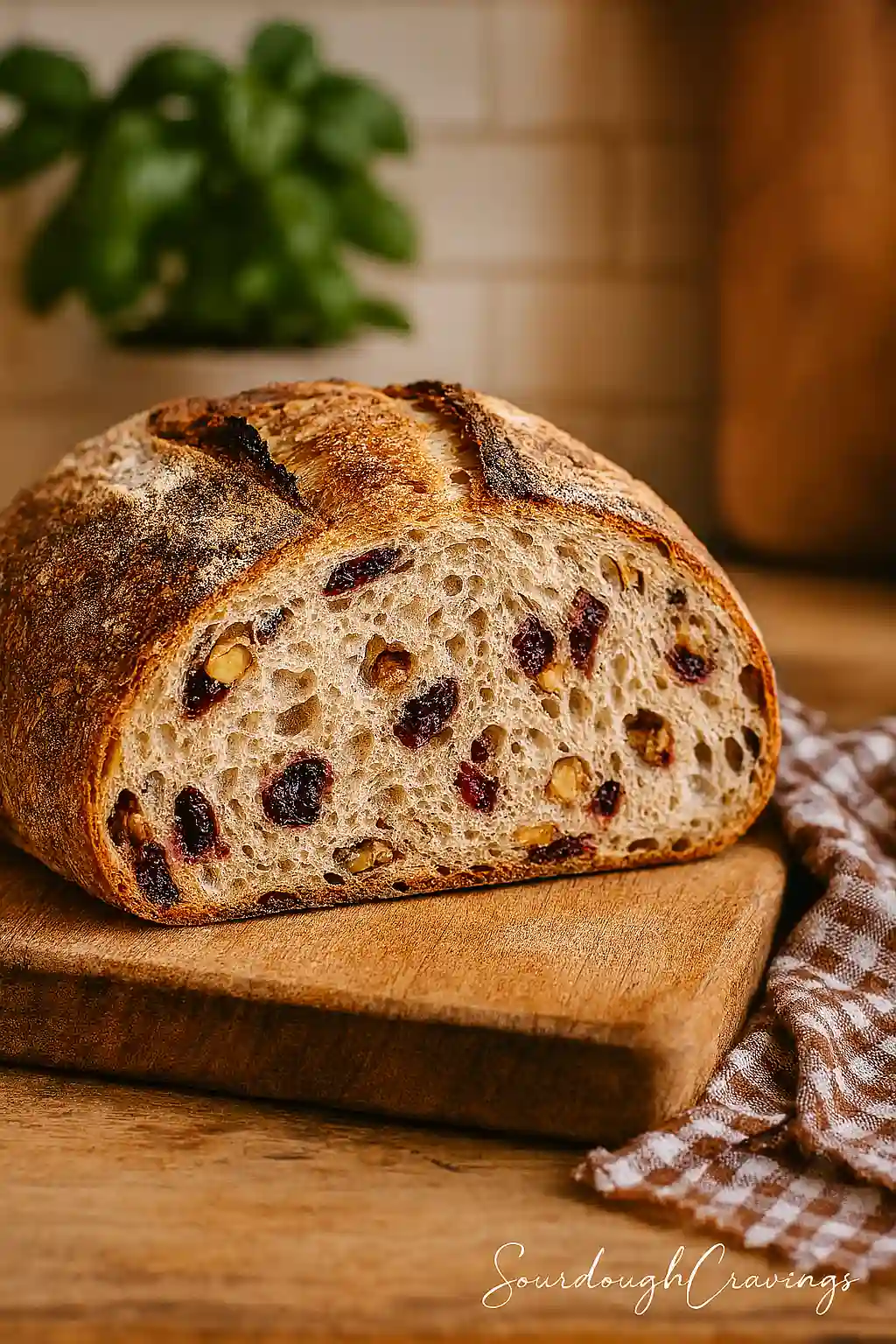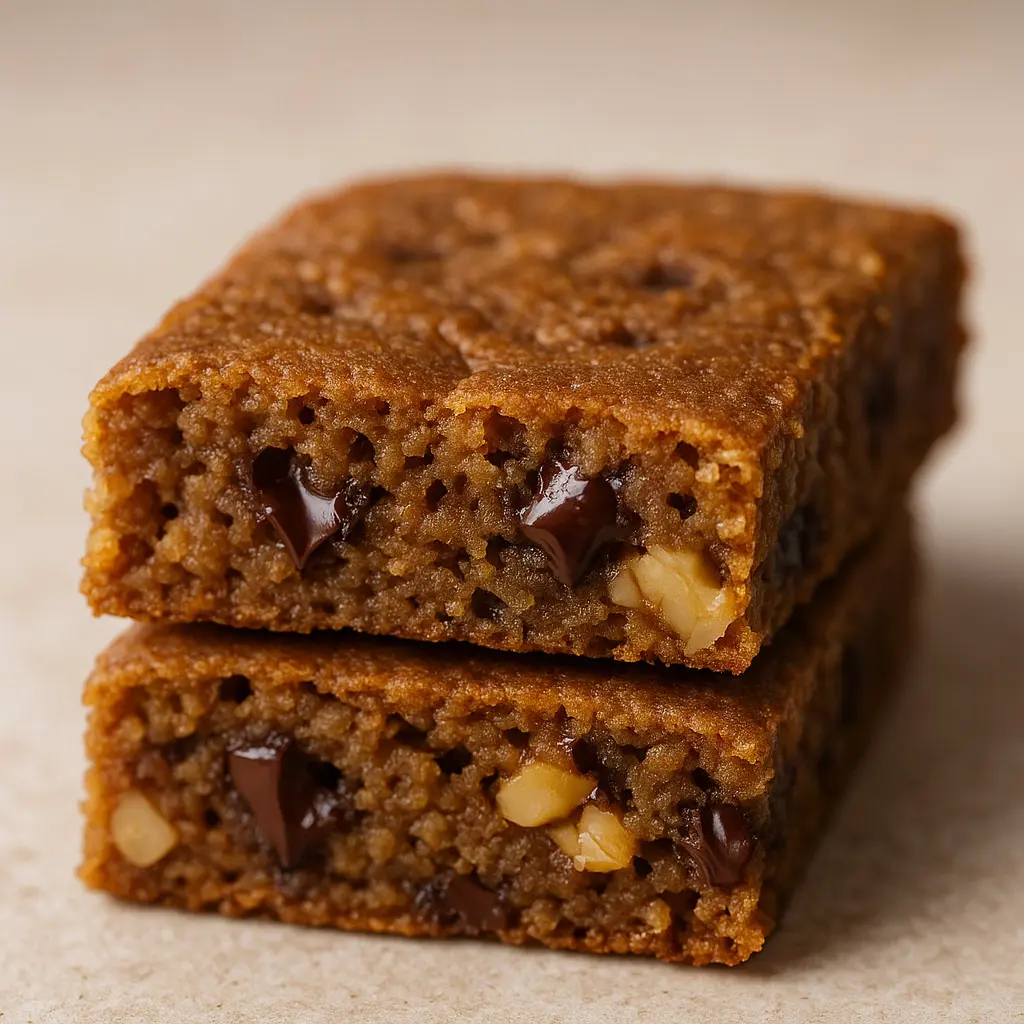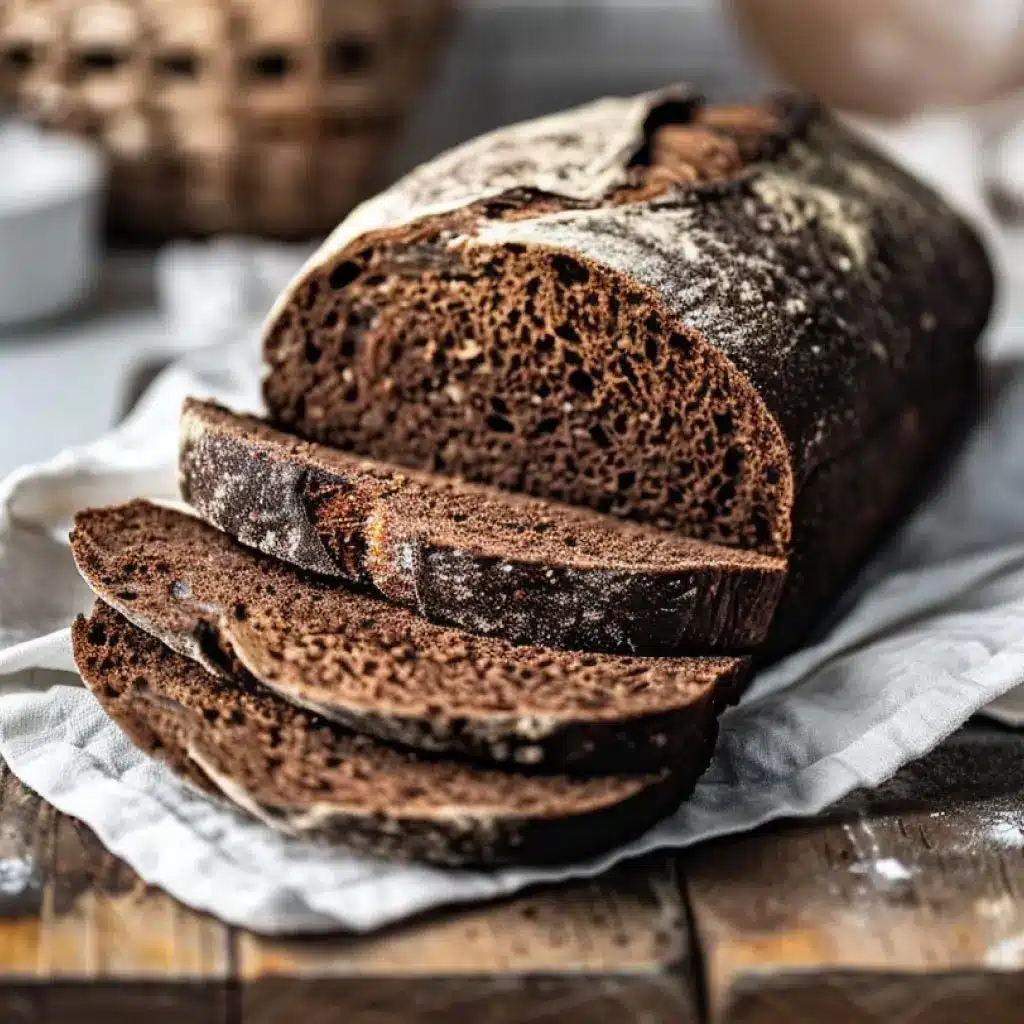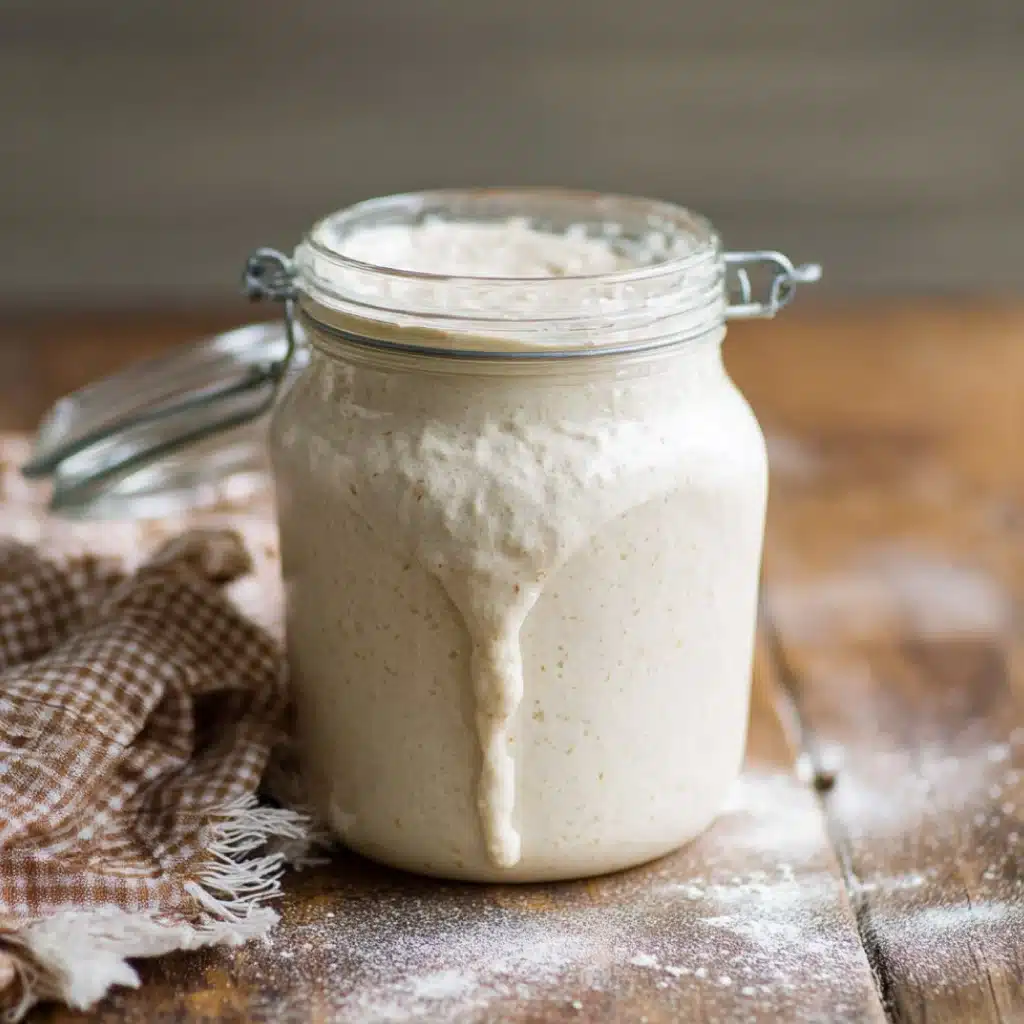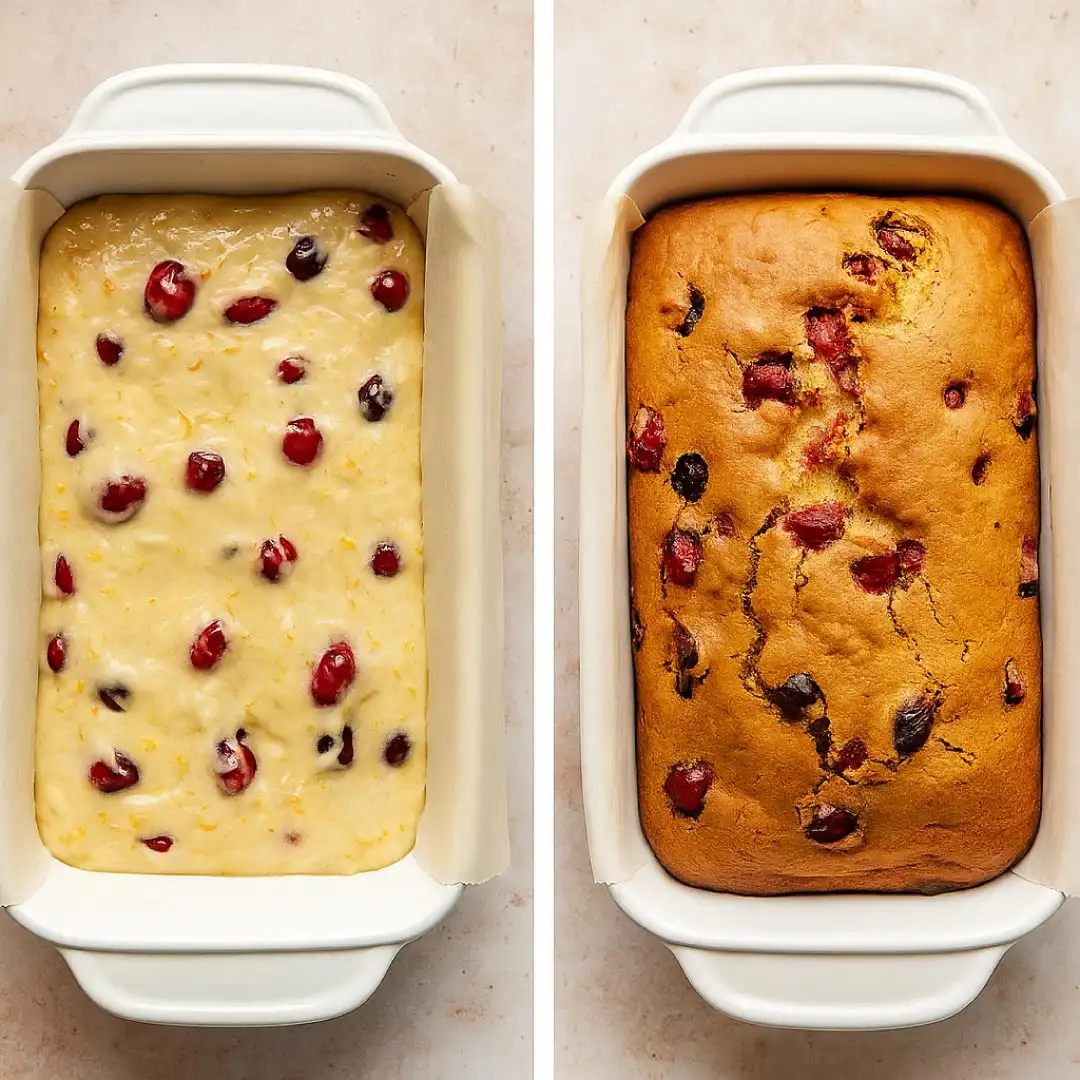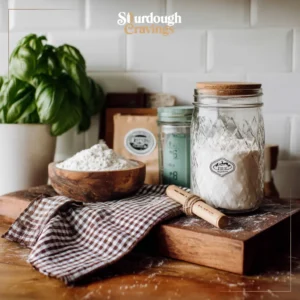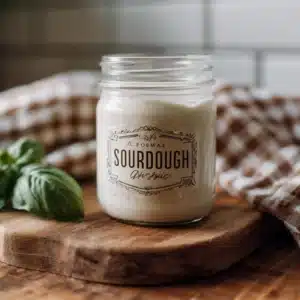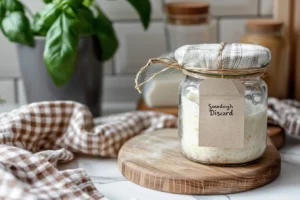Why You Should Freeze Sourdough Discard
When I first began baking with sourdough, I didn’t think much about what to do with the extra starter. Every time I fed it, I scraped a portion into the trash, trying not to feel guilty about wasting so much flour. I told myself it was part of the process — that “discard” meant it wasn’t useful anymore. But after a few weeks, I started to wonder: what if there was a better way?
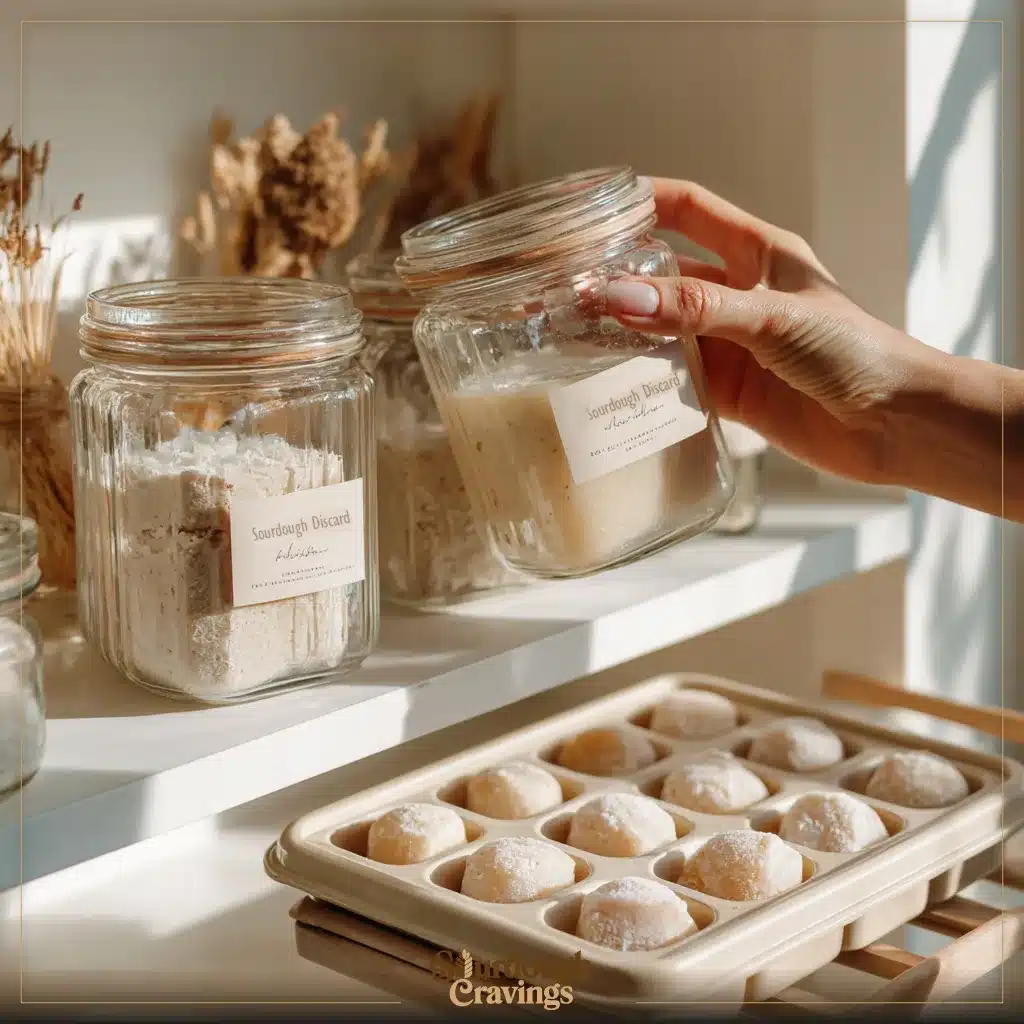
One day, almost on impulse, I decided to try freezing it. I wasn’t sure what would happen — could you really freeze sourdough discard without ruining it? Would it still rise, or would it die off completely in the cold? It felt like an experiment worth trying, if only to save all that effort from going to waste.
That little experiment changed everything. I realized that freezing discard is one of the simplest, smartest habits a home baker can build. It saves time, money, and ingredients — but more importantly, it gives you flexibility. You’re no longer tied to the rhythm of feedings or forced to bake just to keep up with your starter. Instead, you can build a small collection of discard that’s ready to go whenever inspiration (or hunger) strikes.
Freezing also means you never have to feel guilty about throwing away something perfectly good. Each frozen portion becomes an opportunity — for pancakes on a lazy Sunday, biscuits for dinner, or crackers baked on a whim. And the process couldn’t be easier.
In this guide, I’ll walk you through how to freeze sourdough discard properly so it stays fresh, flavorful, and ready for baking months later. I’ll also share the mistakes I made early on so you can skip them entirely.
If you haven’t read my post on Sourdough Discard Shelf Life: How Long It Lasts, it’s worth checking out next — it’ll help you understand when freezing is the right choice and when your discard is still best used fresh.
Because once you realize how simple it is to freeze and reuse discard, you’ll never see it as “waste” again.
Can You Freeze Sourdough Discard? (The Short Answer)
Yes, you can absolutely freeze sourdough discard, and once you try it, you’ll wonder why you didn’t start sooner. The idea might sound a little odd at first — freezing something that’s alive — but it works beautifully. What freezing does is slow everything down. The wild yeast and bacteria inside the discard don’t die; they simply rest. When you thaw it, they wake back up, ready to add flavor and texture to your baking. For a deeper look at how sourdough discard behaves and why it’s so versatile, check out Sourdough Discard 101 — it’s the ultimate guide to understanding and using discard the right way.
I remember the first time I tried it. I had way too much discard sitting in the fridge, and I couldn’t stand the thought of throwing it away again. So, I poured a bit into a jar, labeled it, and tucked it into the freezer, not expecting much. A few weeks later, I thawed it, stirred it smooth, and used it for pancakes — and it was perfect. The flavor was still sharp and pleasant, the texture smooth and creamy. It behaved exactly like fresh discard.
Freezing doesn’t turn your discard into something different; it just pauses it. The only thing to keep in mind is that frozen discard isn’t meant to replace your active starter — it won’t spring back to full strength on its own. But for baking recipes where you’re using it for flavor, like biscuits, crackers, cookies, or waffles, frozen discard works like a charm.
So yes, you can safely freeze sourdough discard without losing its usefulness or character. It’s a simple way to stop wasting flour and time while keeping a backup ready for when inspiration strikes.
If you decide to give it a try, clean containers and good labeling are key — and in the next section, I’ll walk you through the best way to do that so your frozen discard stays fresh and ready for months.
Best Ways to Freeze Sourdough Discard
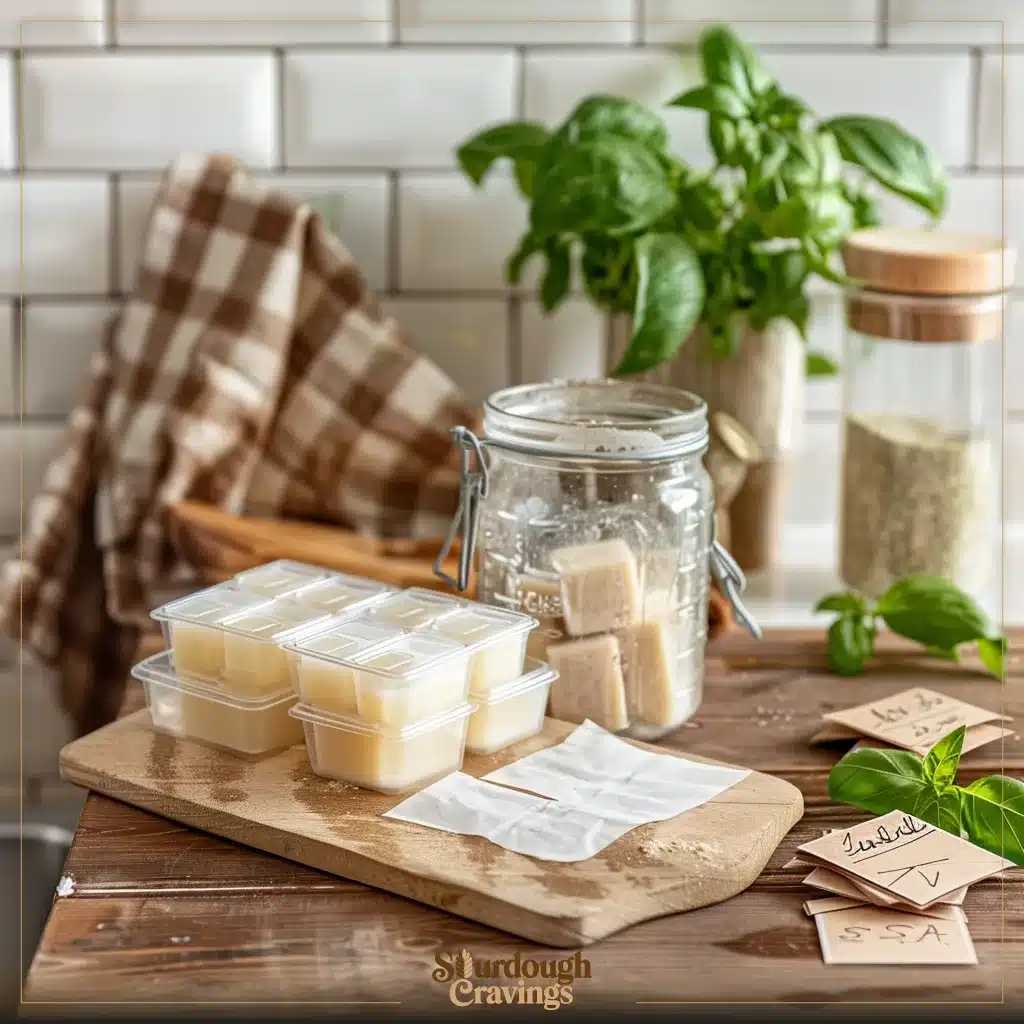
Once you realize that you can safely freeze sourdough discard, the next step is learning how to do it properly. There’s a bit of technique involved, but nothing fancy — just a few simple habits that make your frozen discard last longer and taste as good as the day you stored it.
When I first started freezing mine, I made every mistake possible. I filled jars too full, forgot labels, and ended up with frozen blocks that I couldn’t separate. But after some trial and error, I found a routine that keeps things organized and easy.
The first rule: portion before you freeze. Don’t pour everything into one large container. Instead, freeze it in small amounts — about half a cup each. That way, when you want to bake, you can grab just what you need without defrosting the whole batch. Ice cube trays or silicone molds work perfectly for this. Once solid, you can pop the cubes out and store them in a labeled freezer bag or jar.
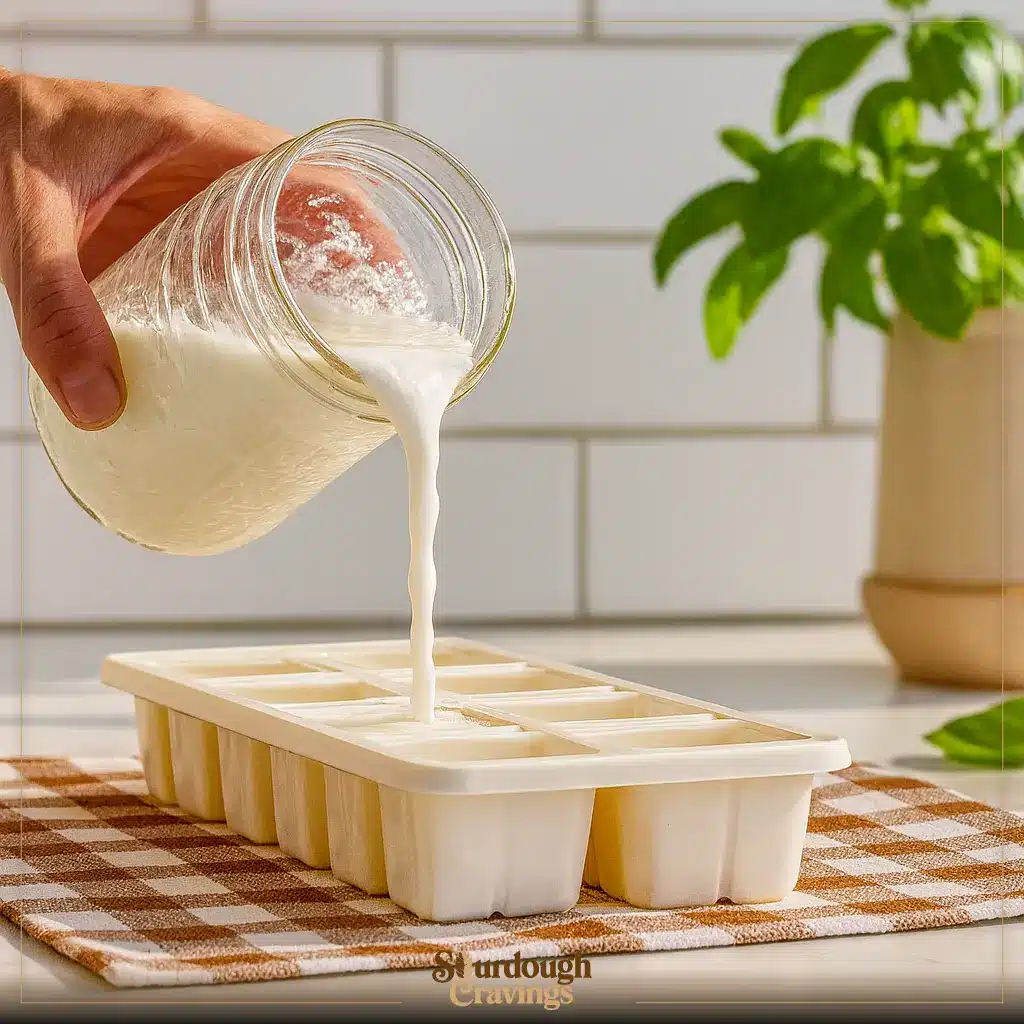
The second rule: use the right containers. Glass jars are great, but they can crack if filled too high or frozen too quickly. Always leave about an inch of space at the top for expansion. If you prefer plastic, make sure it’s food-grade and airtight. I personally like freezer-safe silicone containers because they’re flexible and easy to stack.
The third habit that saves me time later is labeling everything. I know it sounds tedious, but you’ll thank yourself when you open the freezer a month from now. Write the date, portion size, and maybe even what starter it came from if you keep more than one. Sourdough discard stays at its best for about three months in the freezer, so those little notes help you rotate through it before the flavor fades.
If you’re using freezer bags, flatten them before freezing. Press out the air, seal tightly, and lay them flat so they freeze in thin, stackable layers. Once frozen, you can file them upright like folders — neat, space-saving, and easy to see.
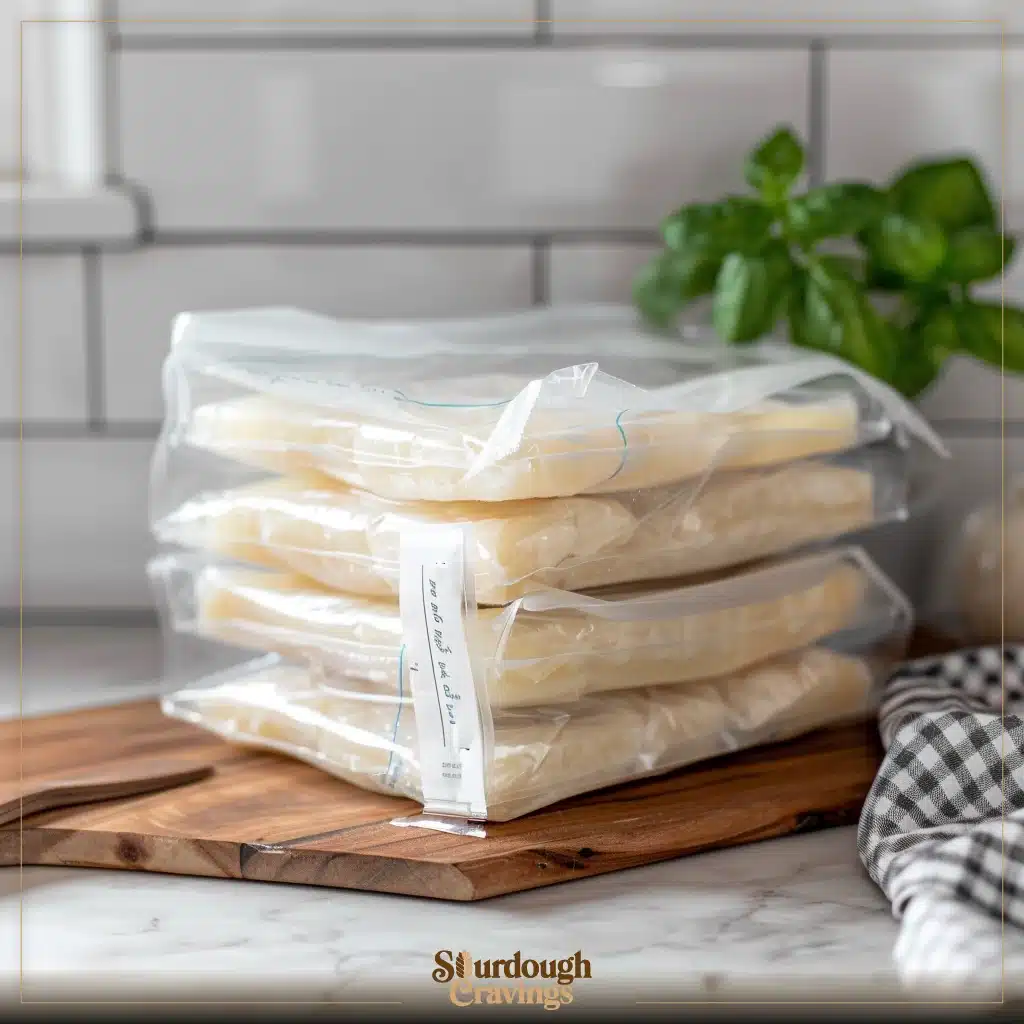
And one last tip: never refreeze thawed discard. Once it’s been defrosted, use it up. Re-freezing will change the texture and weaken the flavor. If you’re not sure how much you’ll need at a time, freeze smaller portions so you can use them as you go.
These little steps make a big difference. When you freeze sourdough discard this way, you’re setting yourself up for effortless baking later on — a ready stash of flavor you can rely on anytime. I like to think of each frozen cube as a tiny piece of potential, just waiting for the right recipe.
Next, let’s talk about how long frozen discard actually lasts and what happens once it’s thawed.
How Long Frozen Discard Lasts (and What to Expect)
The first time I decided to freeze sourdough discard, I wasn’t sure what to expect. Would it lose its flavor? Would it separate? Could it really survive weeks in the freezer and still bake up the same way? The good news is, it does — and much better than you might think.
When frozen properly, sourdough discard keeps well for up to three months without any noticeable change in quality. Some bakers stretch that timeline to six months, and while it technically stays safe to use, the flavor tends to fade a bit after the first few months. I’ve found that the sooner you use it, the better the results — especially for recipes where flavor makes all the difference. For a full breakdown of how sourdough discard behaves over time and how to store it properly, check out Sourdough Discard 101.
If you freeze sourdough discard in clean, airtight containers or sealed bags, the texture will stay smooth and consistent. When you’re ready to use it, move it to the refrigerator and let it thaw slowly overnight. This gentle thawing helps preserve its structure and keeps the flavor balanced. Rapid thawing — like leaving it on the counter or microwaving it — can cause separation or change the texture, so take your time. According to the U.S. Department of Agriculture’s food freezing guidelines, slow refrigeration thawing is the safest way to preserve both quality and safety.
Once it’s thawed, give it a good stir before using it. You might notice a thin layer of liquid on top — that’s just hooch, a natural byproduct of fermentation. Stirring it back in brings everything together and gives your discard that familiar sourdough tang.
As for the smell, it should still have that mild, pleasant tangy scent. If it smells harsh, alcoholic, or even faintly rancid, that’s a sign it’s been in the freezer too long or wasn’t sealed properly. In that case, it’s better to toss it and start with a fresh batch.
The biggest change you might notice in frozen discard is that it won’t behave exactly like an active starter — and that’s completely fine. It’s not meant for making bread rise; it’s for adding depth, flavor, and a bit of that sourdough character to your baking.
I’ve baked everything from crackers to waffles with frozen discard that had been stored for months, and honestly, it performed beautifully every time. The texture was the same, the flavor was still balanced, and it saved me the guilt of throwing away something valuable.
So, if you’re wondering how long you can safely freeze sourdough discard, three months is the sweet spot. After that, it won’t hurt you, but it may not taste its best. Keeping a small rotation — using older portions first and freezing new ones as you go — helps you always have fresh discard on hand.
Next, we’ll go over how to thaw your frozen discard the right way and how to use it once it’s ready — because knowing how to store it is only half the story.
How to Thaw and Use Frozen Sourdough Discard
When you freeze sourdough discard, it feels like you’re bottling up a little piece of potential — something you can come back to when life slows down enough to bake again. But how you bring it back matters just as much as how you stored it. Thawing discard isn’t about speed; it’s about letting it wake up slowly, the same way you’d stretch before a long walk. If you haven’t yet frozen yours, start by reading How to Freeze Sourdough Discard (Coming Soon) for the best storage techniques and portioning tips.
The best way to thaw frozen discard is the simplest one: move it from the freezer to the refrigerator the night before you want to use it. That slow, gentle thaw gives it time to settle and keeps the texture creamy and smooth. By morning, it’ll look almost the same as when you froze it — maybe a little separated, but that’s normal. Just stir it until everything comes together again. For guidance on choosing between the fridge and freezer depending on how often you bake, you can check Refrigerator vs Freezer: Best Discard Storage. (Coming Soon)
If you forget to plan ahead, you can let it sit out at room temperature for a couple of hours. It’ll thaw faster that way, though I always prefer the slower fridge method — it keeps the flavor brighter and the texture more consistent. Whatever you do, don’t microwave it or try to rush the process with hot water. I’ve tried both out of impatience, and the result was a sad, rubbery mess that smelled a bit like burnt cheese. Trust me — give it time. According to King Arthur Baking’s guide on sourdough care, gradual temperature changes help preserve the natural yeast and bacteria that give sourdough its signature flavor.
Once thawed, your discard should smell pleasantly sour — not harsh, not sharp, just gently tangy like yogurt. The texture will be thick but pourable, perfect for recipes like pancakes, waffles, biscuits, or crackers. In fact, I’ve found thawed discard even easier to mix into batter than fresh — it blends smoothly, and the flavor mellows just enough to work beautifully in both sweet and savory bakes.
Here’s the one thing to remember: thaw only what you need. Discard doesn’t like to be frozen twice. When you freeze sourdough discard in small portions, you can take out just one serving at a time — enough for a morning batch of pancakes or a tray of crackers. That way, nothing goes to waste, and you’ll always have fresh discard ready when the urge to bake hits.
When you take your time thawing it, something small but special happens. You reconnect with the rhythm of sourdough — that quiet patience it teaches you without words. The jar goes from solid and still to soft and alive again, carrying that familiar scent that reminds you why you started baking in the first place.
Next, we’ll talk about the mistakes to avoid when freezing discard — the small, easy-to-overlook details that can save you a lot of frustration (and a few cracked jars).
Mistakes to Avoid When Freezing Discard
If you’ve ever tried to freeze sourdough discard for the first time, you probably know how easy it is to get something wrong. I made nearly every mistake you can imagine — cracked jars, forgotten dates, and bags so full I had to chip away at them with a spoon. Freezing discard isn’t complicated, but a little care goes a long way. Here are a few lessons I’ve learned the hard way so you don’t have to.
1. Filling Containers to the Top
It’s tempting to squeeze in just a little more, but don’t. Discard expands as it freezes, and if your jar or container is too full, the lid will pop or the glass might crack. Leave about an inch of space at the top — it feels wasteful at first, but it’ll save you from a sticky mess later.
2. Forgetting to Label Your Jars
This might sound like a small thing, but it’s one of the biggest culprits behind wasted discard. Once it’s frozen, every jar looks the same. Always write the date and portion size on the lid or a piece of masking tape. That simple habit helps you use the oldest batch first and keeps your freezer from turning into a sourdough graveyard.
3. Re-Freezing Thawed Discard
Once you’ve thawed your discard, don’t put it back in the freezer. The texture and flavor break down each time it’s frozen and thawed, and what comes out the second time around won’t taste right. It’s better to freeze sourdough discard in smaller portions so you can defrost just what you need for a recipe.
4. Leaving Air in the Container
Air is the enemy of anything frozen. It dries out the surface and can give your discard a strange, freezer-burned taste. Always press out excess air from bags before sealing, or use jars that close tightly. I’ve started placing a small piece of parchment paper over the surface of my discard before sealing the lid — it keeps it fresher for longer.
5. Skipping the Stir After Thawing
Even when you’ve done everything right, thawed discard can separate a little. You might see a thin liquid layer on top — that’s totally normal. Give it a gentle stir before using, and it’ll come right back to the creamy, tangy texture you’re used to.
Freezing discard isn’t about perfection — it’s about being mindful. Once you learn these little tricks, the process becomes second nature. Every jar you tuck into the freezer becomes a quiet act of saving: saving time, saving ingredients, saving a piece of your effort.
When you freeze sourdough discard the right way, you end up with a freezer full of potential — ready to turn into something warm and comforting whenever you need it.
Next, we’ll look at some of the best ways to use your frozen discard once it’s thawed — from quick breakfasts to simple snacks that taste far better than anything store-bought.
Creative Recipes Using Frozen Sourdough Discard
The first time I learned to freeze sourdough discard, I felt relieved — no more waste, no more guilt. But the real magic happened when I realized how easy it was to turn that frozen discard into something delicious. Once you thaw it, you’re not just holding leftovers — you’re holding a base for an entire meal, a snack, or even dessert.
Here are a few of my favorite ways to use thawed discard — recipes that have become part of my kitchen rhythm.
1. Sourdough Pancakes and Waffles
This is where I started, and it never fails. Thawed discard gives pancakes that perfect tang — not too sharp, just deep enough to make them special. Mix one cup of thawed discard with an egg, a splash of milk, a bit of baking soda, and a spoonful of sugar. The result? Pancakes that are light, golden, and slightly crisp at the edges. Waffles work the same way — just use a bit more fat or butter in the batter for that perfect crunch.
2. Savory Crackers or Flatbreads
When I have extra discard in the fridge or freezer, I make sourdough crackers. Mix your thawed discard with olive oil, herbs, and a pinch of salt. Spread it thin on a baking sheet and bake until crisp. It’s a simple way to turn something small into a snack that tastes like it came from a bakery. Sometimes I roll it with sesame seeds or sprinkle flaky salt on top — small touches that make a big difference.
3. Buttery Biscuits and Drop Scones
Thawed discard works beautifully in biscuits. It gives them a tender crumb and a gentle sour edge that pairs perfectly with butter or jam. I like to keep a portion in the fridge just for mornings when I crave something warm. Mix one part discard with one part flour, a bit of baking powder, and enough butter to hold it together. Drop spoonfuls onto a baking sheet, and bake until golden.
4. Pizza Dough with a Tangy Twist
This one feels almost too good to be true. Add thawed discard to your regular pizza dough for a boost of flavor. It won’t act as your main leavening agent, but it adds depth — that slightly tangy, complex taste that makes homemade pizza stand out. I use about half a cup of discard per pizza base.
5. Muffins and Quick Breads
For something sweet, add your thawed discard to banana bread, blueberry muffins, or even chocolate loaf cakes. It brings a subtle tang that balances sweetness and keeps baked goods moist. You’ll notice the texture — softer, more tender, and just a bit richer than usual.
The beauty of learning to freeze sourdough discard is that you never run out of ideas or ingredients. It’s a quiet little secret that turns “extras” into opportunities — something comforting waiting in your freezer, ready to be turned into breakfast, a snack, or a small gift for someone you love.
Every time I pull a jar from the freezer, I think of it less as discard and more as a piece of possibility. Flour, water, and time — that’s all it takes. And somehow, it always feels like more than enough.
Next, we’ll wrap everything up with the key takeaways — the small reminders that’ll help you make the most of your frozen discard every single time.
Key Takeaways & Final Thoughts
I didn’t plan to start saving my sourdough discard. Honestly, it just happened one day — I was standing by the sink, spoon in hand, about to scrape it out like I always did. But something about it stopped me. I looked down at that jar — at the soft bubbles, that familiar tang — and I thought, this took time to grow. It didn’t feel right to throw it away.
So I found a clean jar, poured the extra in, wrote the date on a piece of tape, and slid it into the freezer. That was it. No big moment, no fancy plan. Just a quiet choice. I didn’t know then that learning to freeze sourdough discard would change the way I bake — and maybe, a little, the way I live.
At first, it was just about not wasting flour. But after a while, it became something else — something softer. It became about slowing down. About realizing that not everything you set aside is forgotten. Some things — like sourdough — just need a little time to rest.
Now, when I open the freezer, I see a few jars lined up along the back. They’re small, nothing special — bits of time I decided to keep. Some are from busy weeks when I didn’t bake at all, some from quiet weekends when I just wanted to feed the starter because it felt good to do something slow. Each one is a reminder that care doesn’t have to be constant to count.
Freezing discard taught me that baking isn’t about control. It’s about rhythm. You feed, you wait, you pause, you return. It’s not failure to take a break — it’s part of the process. And that’s what I love about it.
When I take a jar out to thaw, I always stop for a second before opening it. It’s such a small thing — that faint sour smell, the soft texture coming back to life — but it feels grounding. It’s proof that something you cared for quietly, something you tucked away, can still wake up when you’re ready for it.
You don’t need perfect jars or fancy labels to do this. You just need a little bit of care.
Scoop your discard into something clean, label it, and let it rest in the freezer. That’s it. You’re not saving scraps; you’re saving moments. You’re giving yourself space — to rest, to live, to return later without guilt.
That’s what learning to freeze sourdough discard really means to me now. It’s not about bread anymore. It’s about patience. About learning that slowing down doesn’t mean giving up. That you can pause, step back, breathe — and when you’re ready, pick up right where you left off.
Because the truth is, nothing you care for ever really goes to waste.
Not a jar of starter. Not a bit of time. Not you.

